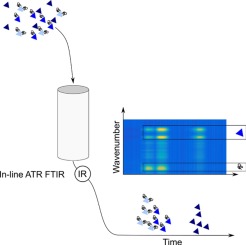Journal of Chromatography A ( IF 3.8 ) Pub Date : 2018-03-05 , DOI: 10.1016/j.chroma.2018.03.005 Steffen Großhans , Matthias Rüdt , Adrian Sanden , Nina Brestrich , Josefine Morgenstern , Stefan Heissler , Jürgen Hubbuch

|
Fourier-transform infrared spectroscopy (FTIR) is a well-established spectroscopic method in the analysis of small molecules and protein secondary structure. However, FTIR is not commonly applied for in-line monitoring of protein chromatography. Here, the potential of in-line FTIR as a process analytical technology (PAT) in downstream processing was investigated in three case studies addressing the limits of currently applied spectroscopic PAT methods. A first case study exploited the secondary structural differences of monoclonal antibodies (mAbs) and lysozyme to selectively quantify the two proteins with partial least squares regression (PLS) giving root mean square errors of cross validation (RMSECV) of 2.42 g/l and 1.67 g/l, respectively. The corresponding Q2 values are 0.92 and, respectively, 0.99, indicating robust models in the calibration range. Second, a process separating lysozyme and PEGylated lysozyme species was monitored giving an estimate of the PEGylation degree of currently eluting species with RMSECV of 2.35 g/l for lysozyme and 1.24 g/l for PEG with Q2 of 0.96 and 0.94, respectively. Finally, Triton X-100 was added to a feed of lysozyme as a typical process-related impurity. It was shown that the species could be selectively quantified from the FTIR 3D field without PLS calibration. In summary, the proposed PAT tool has the potential to be used as a versatile option for monitoring protein chromatography. It may help to achieve a more complete implementation of the PAT initiative by mitigating limitations of currently used techniques.
中文翻译:

在线傅里叶变换红外光谱作为制备型蛋白质色谱的通用过程分析技术
傅里叶变换红外光谱(FTIR)是一种用于分析小分子和蛋白质二级结构的成熟光谱方法。但是,FTIR通常不用于蛋白质色谱的在线监测。在此,在三个案例研究中研究了在线FTIR作为下游分析中的过程分析技术(PAT)的潜力,以解决当前应用的光谱PAT方法的局限性。第一个案例研究利用单克隆抗体(mAbs)和溶菌酶的二级结构差异,通过偏最小二乘回归(PLS)选择性地定量了两种蛋白质,得出交叉验证的均方根误差(RMSECV)为2.42 g / l和1.67 g / l。对应的Q 2值分别为0.92和0.99,表示校准范围内的鲁棒模型。第二,监测溶菌酶和聚乙二醇化溶菌酶种类的分离过程,从而估计当前洗脱物质的聚乙二醇化程度,溶菌酶的RMSECV为2.35 g / l,聚乙二醇的为1.24 g / l,Q 2分别为0.96和0.94。最后,将Triton X-100作为典型的过程相关杂质添加到溶菌酶的进料中。结果表明,无需进行PLS校准,即可从FTIR 3D场中选择性地对物种进行定量。总之,提出的PAT工具有潜力用作监测蛋白质色谱的通用选择。通过减轻当前使用的技术的局限性,这可能有助于实现PAT计划的更完整实施。











































 京公网安备 11010802027423号
京公网安备 11010802027423号